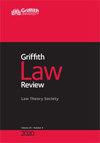State of undress: law, carnival and mass public nudity events
IF 0.9
Q1 LAW
引用次数: 1
Abstract
ABSTRACT This article uses cultural analysis to explain why mass public nudity events are excepted and exempted from the typical legal regulations around public nudity. It uses two specific examples, namely the London version of the World Naked Bike Ride and the Tasmanian Nude Solstice Swim, to illustrate the broader connections between mass public nudity events and systems of dress regulation. It argues that whilst the legal allowance of these events breaks from the general pattern of prohibitions around public nudity, this disparity can be accounted for by reading these events through the interpretive framework of Mikhail Bakhtin’s concept of ‘carnival’. This framework reveals that these licensed forms of carnival transgression affirm the limits of the dress regulations that they superficially appear to challenge, and that the legal allowance of these events performs the same function as the typical legal regulations around public nudity.脱衣服状态:法律、狂欢节和大规模公共裸体活动
摘要本文运用文化分析的方法来解释为什么大规模公共裸体事件被排除在典型的公共裸体法律法规之外。它使用了两个具体的例子,即伦敦版的世界裸体自行车骑行和塔斯马尼亚裸体冬至游泳,来说明大规模公共裸体活动与着装监管系统之间更广泛的联系。它认为,虽然对这些事件的法律允许打破了禁止公众裸体的一般模式,但通过米哈伊尔·巴赫金“狂欢节”概念的解释框架来解读这些事件,可以解释这种差异。这一框架表明,这些许可形式的狂欢节违规行为肯定了他们表面上似乎挑战的着装规定的局限性,并且这些活动的法律许可与围绕公众裸体的典型法律规定具有相同的功能。
本文章由计算机程序翻译,如有差异,请以英文原文为准。
求助全文
约1分钟内获得全文
求助全文

 求助内容:
求助内容: 应助结果提醒方式:
应助结果提醒方式:


